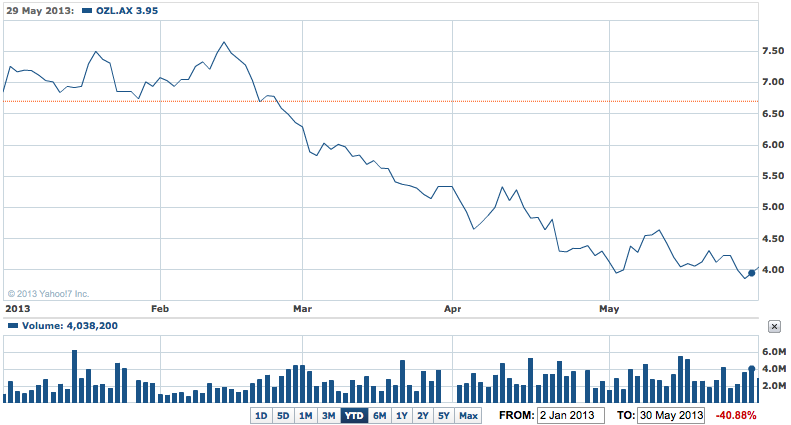OZ Minerals’ shares look like ending the week above $4, and off the back of a sharp dip under that level during the week, after Tuesday’s AGM. The shares ended at $4.05 yesterday, compared with a $4.06 close last Friday.
Investors took the opportunity at the AGM to get a lot of angst off their chests, especially about the consistent fall in the share price in the past year. The shares hit a low of $3.82 this week and a year ago were trading at $9.02. $3.82 is the lowest the shares have been for more than three years.
But they have rebounded from that low and are now up around 5%, which is some encouragement.
Much of the fall has come in the past three months as falling copper and gold prices and rising production costs at its Prominent Hill operation in South Australia have crimped profit margins. In fact OZ Minerals barely broke even in the March quarter and investors were left to ponder that the production outlook was downgraded as well.
OZL YTD – Shares steadying?

”Like most resource companies we are trading at a very significant discount to our fundamental value: be that our NTA [net tangible assets] or any net present value calculation,” chairman Neil Hamilton told the AGM.
”I can’t tell you why such a discount is justified. It is industry-wide … perhaps the discount is greater because of where we find ourselves in this life-of-mine program and because we are going through this period of tough cash flow.
"We have indicated that we expect copper production to be lower at the level of 82 to 88 thousand tonnes of copper in 2013, impacted by operational issues and logistical challenges within the pit.
"As I said, it was always the case that we would have this challenge of moving significant volumes of waste in these years, but it is an investment that will enable us to achieve strong future production from the Prominent Hill mine.
"From 2014 onwards we begin to see the benefit of this waste movement campaign as the strip ratio decreases and there is increased access to ore in the subsequent stages of the open pit, enabling strengthening cash flows in subsequent years.
"We entered this phase of the mine plan with a strong balance sheet, significant cash reserves and no debt. As a result of the cost of these significant material movements there was limited cash surplus generation in 2012 and we expect a decrease in cash resources through 2013.
"In 2012 we paid dividends of nearly $125 million out of our operating profit in accordance with our stated dividend policy of returning 30 to 60% of normal operating profits. We also completed an on- market share buy-back which had commenced in 2011. Our financial position remains strong," he said.
Some shareholders grumbled about the two buybacks conducted over the past two years at $10.51 and $9.18 a share. But that is hindsight management and those shareholders who sold into the buyback are no doubt not as upset as those who didn’t.
Mr Hamilton told one questioner at the AGM that in hindsight it probably would have been better not to have had the buybacks, but shareholders would equally have been better off than before if the share price went up.
OZL is a single mine company depending on the Prominent Hill mine in South Australia, which Mr Hamilton says the company is confident of extending its productive life to 2030.
But OZL also has the Carrapateena copper-gold project (also in South Australia) but its immediate future is in some doubt. It’s an expensive project – probable cost, $3 billion. It cost around $250 million to buy.
But no decision to go ahead with the mine has been made and at the AGM Mr Hamilton indicated the board had decided to delay building an exploration decline there until further studies and testing had been completed.
Plans to use a boring machine to excavate an exploratory tunnel into the deposit (which lies deep underground) and carry out a pre-feasability study are now too expensive. That’s after tenders from potential contractors to OZ came in higher than expected.
“One of the things we have been trying to do with this project is to accelerate it to get to a decision, to get more information,” Chief Executive Officer Terry Burgess said in an interview with Bloomberg following the meeting. “I think we are realizing that this was costing us extra money, by asking the contractors to do things more quickly.”
The company will focus on lowering its production costs and the costs of contracts with suppliers last agreed at the height of Australia’s mining investment boom, Burgess said. The company said today it had revised its cost forecast to as much as $US1.80 per pound of copper for 2013 from $US1.20 in 2012.
Mr Burgess says a decision will be made on the viability of the Carrapateena mine in 2015, when hiring mining services contractors will hopefully be cheaper than they are now as service companies cut prices because of falling business.
Burgess told Bloomberg that pressure on copper supply caused by the tunnel collapse at Freeport-McMoRan Copper & Gold Inc.’s Grasberg mine in Indonesia and the suspension of mining at Rio Tinto’s Bingham Canyon in Utah, is likely to bolster metal prices. He said the incidents would probably help keep the price at $3.30 to $3.50 a pound. Copper closed at $US3.31 a pound in New York on Thursday night, our time.













